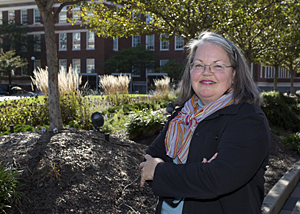Oct 23 2013
Green roofs (or living roofs) are becoming a growing trend in North America – and have been long established in Europe – for their value in conserving energy, improving air quality, managing storm water runoff, beautifying cities and even having a positive psychological impact on communities.
 Virginia Russell
Virginia Russell
A University of Cincinnati researcher and landscape architect is now proposing a better way of identifying green roofs by their characteristics as well as their benefits. Virginia Russell, an associate professor in the UC College of Design, Architecture, Art, and Planning (DAAP), will present her proposal on Oct. 24, at the 11th annual CitiesAlive Annual Green Roof and Wall Conference in San Francisco.
Green roofs are loosely defined as “landscapes over structure,” and the methodology and vocabulary of green roofs are imported from Europe, especially from Germany, where green roofs have been required on most structures for more than 20 years. Currently, there are two categories of green roof that are defined by their maintenance regimens: translated from German, these two categories are “intensive” and “extensive.” Intensive green roofs are deep, heavy, lushly planted, and they are often designed for 100 percent accessibility. The additional features to accommodate human use as well as complex plantings require “intense” maintenance.
By contrast, extensive green roofs are shallow, which limits the plantings to those that can survive in shallow growing medium, and they are less likely to be designed for frequent human access. Their maintenance regimen requires much less than an intensive green roof. Russell says the two words –intensive and extensive – translate into English to mean much the same thing, and therefore, they cause quite a bit of confusion. She says she found it difficult to rationalize the use of the two terms to her students, so she began devising a new vocabulary that would bring the benefits of green roofs into the foreground and associate them with sustainability rather than maintenance.
Russell’s goal is to develop a classification system that identifies regional identity, which will support regional methods and plant palettes rather than generic applications that are alike from coast to coast. This approach will stimulate research and development of uniquely North American green roofs. It will also require an awareness of authentic sustainability: newly classified green roofs will be identified by social and economic benefits as well as their environmental benefits. “Just as animal kingdoms have higher and lower orders, green roofs will have higher orders that are more ‘intelligent’ because of their advanced and highly evolved sustainability measures,” says Russell.
"The list of reasons to justify the development of a classification system for vegetated roofs is not complete without some mention of the difference between tough love and puppy love for vegetated roofs,” Russell writes. “Those involved in the industry – manufacturers, vendors, installers, maintainers, advocates, researchers, educators, users – are responsible for self-examination of motives and outcomes, and the development of a naming system that is closely tied to sustainability will acknowledge that not all vegetated roofs are valuable in such terms.”
Russell is among the nation’s earliest designers in North America to be accredited in green roof design and implementation through Green Roofs for Healthy Cities North America (GRHC), a not-for-profit association dedicated to promoting the green roof industry in North America. Russell is a member of the GRHC Board of Directors and the Editorial Advisory Board for the Journal of Living Architecture. She was featured in GRHC’s anniversary book, “The Rise of Living Architecture” (2012) with noted designers such as William McDonough, Jason McLennan and Cornelia Oberlander.
Funding for Russell’s training and research in living architecture has been supported in part by the UC Faculty Development Council and the UC University Research Council.
The CitiesAlive Conference is exploring how living architecture can improve the resilience of communities. The conference, themed, “Securing Urban Resiliency with Living Architecture: Food-Water-Energy,” will feature more than 100 presentations and discussions.
CitiesAlive is North America's only event dedicated to green roofs and walls and draws up to 1,000 sustainable building professionals working in the green roof and wall sector.